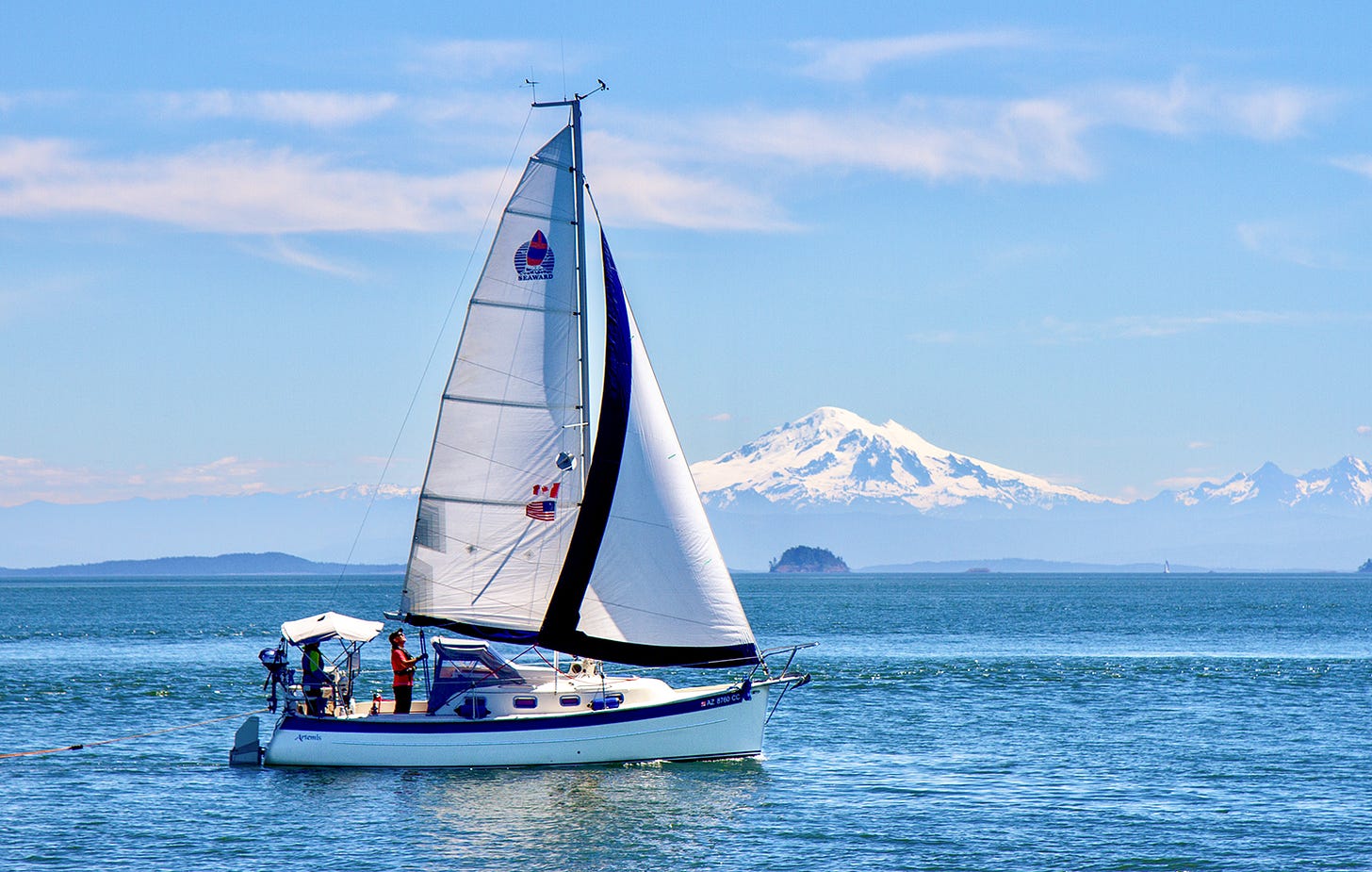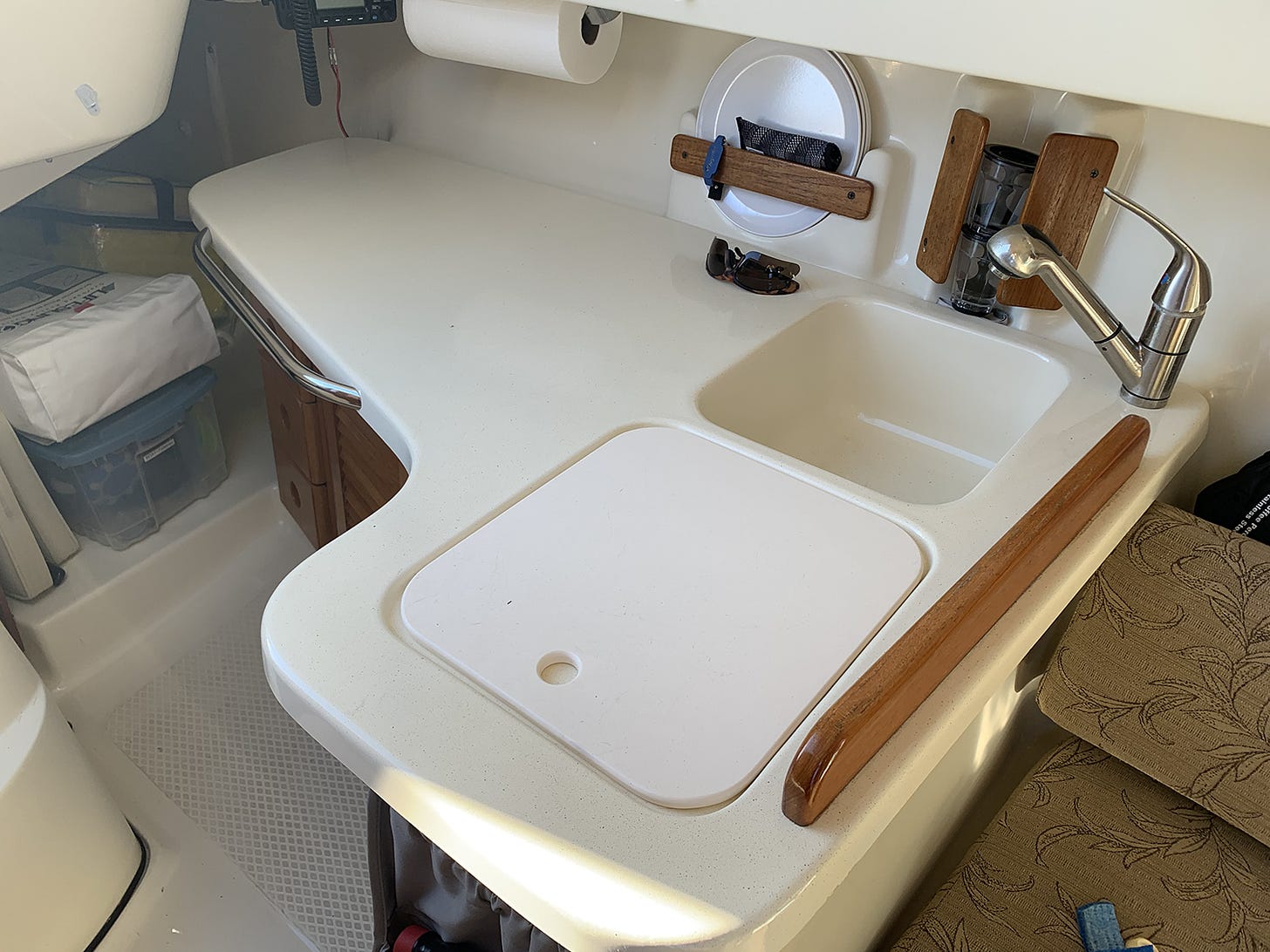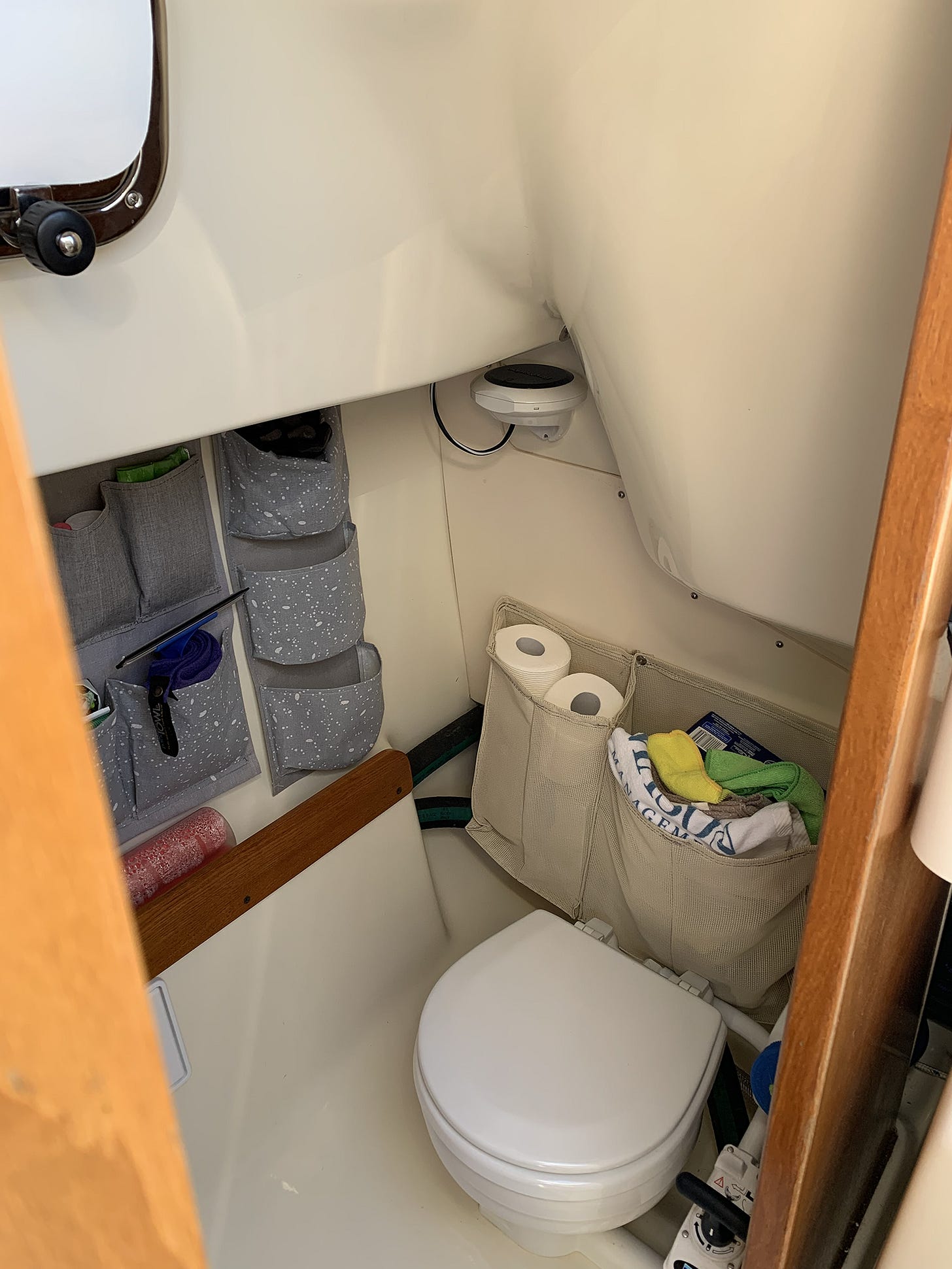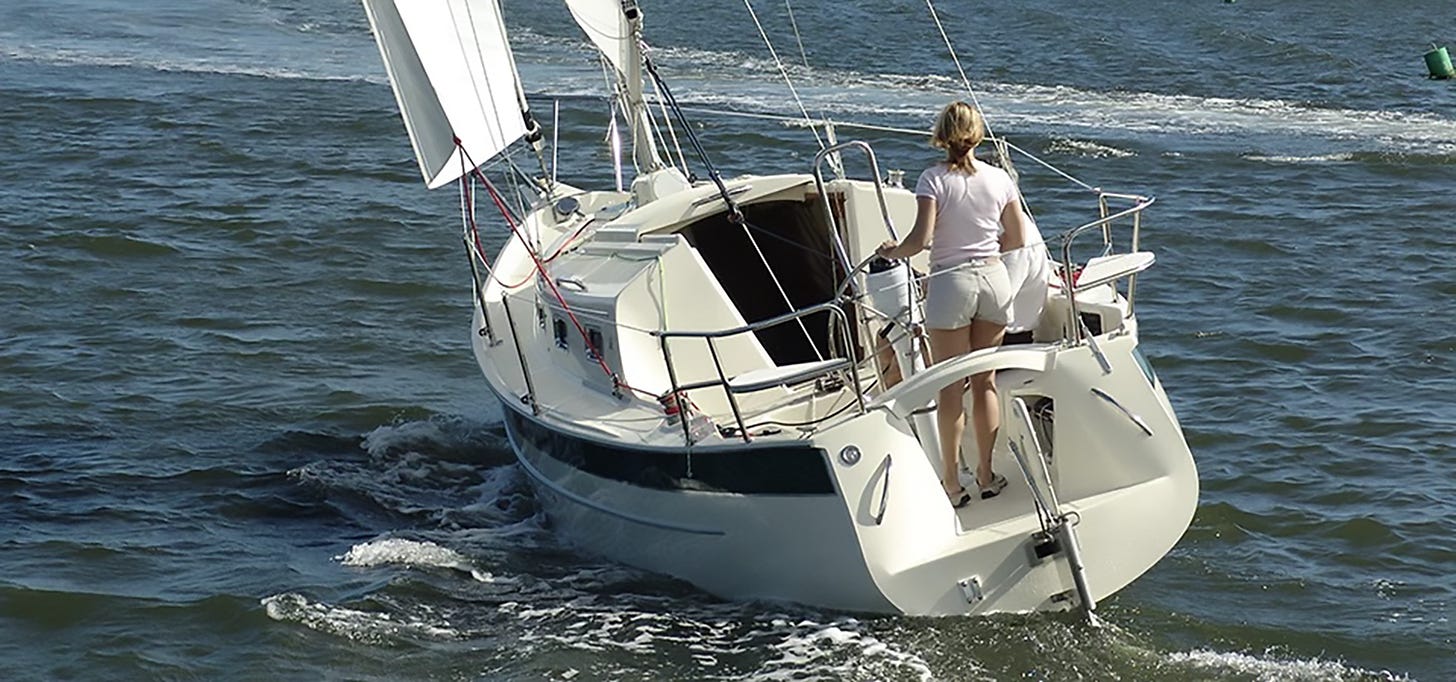My wife and I first came across a Seaward at the Lake Havasu Pocket Cruiser’s Convention in 2011, where some soon-to-be friends had bought it’s older sibling, the Seaward 25. At that time we had a Catalina Capri 18 and what struck us about the Seaward 25 was that it was a full-size trailerable sailboat that had standing headroom for both my wife and I who are 5’-6”.
Despite our admiration of the Seaward 25, we went through a number of other boats before settling on our current favorite. I first let my Capri 18 go, buying a Beneteau First 235, and eventually sold the First 235 to buy a Beneteau First 30…having finally decided to go for a full-size boat with both performance and creature comforts. Fast forward to present day which had my wife and I retiring early and moving from Southern California to Arizona in order to reduce our living expenses. We seriously considered keeping our First 30 in her slip in Long Beach, but after much deliberation we decided that the fixed costs of keeping her in a slip were going to be too much for a “long distance relationship.” What made this decision easier is that we decided to buy a used Seaward 26RK as a replacement, knowing we could keep her in our RV garage when not in use, and trailer her to numerous destinations when we wanted to go sailing.
The Seaward 26RK was manufactured in Stuart, Florida by Hake Yachts. Several years ago the design was sold to Island Packet Yachts which a couple of years ago decided to quit production. The standard boat has a retracting keel and rudder (hence the RK designation). This allows draft of the boat to be adjusted via an electric winch from 18-inches to 6 feet. It has a fairly large V-berth, galley, wet head, salon and a quarter berth that we use for storage. You can sleep 4 people on board but it would be crowded once you add everyone’s equipment and gear. Our boat came with wheel steering and a 2-cylinder Yanmar diesel inboard (tiller steering and outboards were also an option).
So, in September, 2021 my wife and I took a road trip to the east coast where we purchased a 2008 model that could best be described as a diamond in the rough. She came with a Magic Tilt trailer and after an adventurous trip back to Arizona with her in tow, we spent 2-1/2 months cleaning her up, redoing bottom paint, new running and standing rigging, installing instruments, taking care of several years of missed maintenance and renaming her from Adrift to Artemis. The results were fantastic and we ended up with a beautiful boat.
We had the boat in a slip in Lake Havasu for the winter and got to know her by doing some day sailing and an overnight, where we beached the boat on a sandy shore (the plus of 18-inch draft). We found out fairly quickly that to have any control of the boat at slow speeds you had to have the rudder all the way down, approximately 3 feet in the water, and the keel at the halfway point…also about 3 feet in the water. Our first attempt of putting her in the slip with the keel all the way up and the rudder half way in had us skidding in the turn going into our slip and ending up with our bow in the wrong slip! Since then we have not run into any issues other than windage on a blustery day. The ability to adjust the draft also pays dividends when trailering. The boat launches and retrieves like a power boat. Even though the trailer came with a tongue extender we have not had to use it to either launch or retrieve.
Last summer we decided to take our first real adventure with her and trailered the boat to Port Townsend where we decided to spend most of June and July cruising both the Canadian Gulf Islands and the San Juans. In order to get ready for the trip my wife put her Sailrite sewing machine to good use and made a new Bimini and Dodger, using the old ones as patterns. She also made a connecting piece between the two so we could have some rain protection while moored. We also added an 12v, 55-liter refrigerated ice chest with a dedicated lithium-ion battery pack and solar panels. (The boat does not have a dedicated starter and house battery—instead it has two Group 31, 100-amp hour batteries with the simple 1-2-All-off switch). The cooler does take place of the port side settee seats but is well worth it to have cold drinks and keep food refrigerated.
Our boat came with shore power, a hot water heater and it has a 20-gallon potable water tank and a 15-gallon black water tank. We found we could comfortably be off the grid for four days and still have a cold fridge and potable water without too many problems. We also added line bags for the sheets and additional bags inside the cabin to hold charts, spare paper towels, laundry etc. Set up as discussed we entered full cruising mode.
Our first experience of the trip was crossing the Strait of Juan de Fuca on a particularly nasty and lumpy day. We hit several tide rips that had sets of steep, short waves caused by wind over current, and the boat performed exceptionally well. For two adults she is proving to be quite comfortable to cruise in and easy to get in an out of marinas and anchorages. The V-berth is bigger than what we had on our First 30 and with the addition of 4 inches of memory foam, quite comfortable. The one downside of the retractable keel is the large keel compartment which takes up a fair amount of room in the cabin. Our friend’s Seaward 25 had more room inside because of this. The cockpit is spacious and comfortable for sailing. Towing a dinghy we averaged approximately 5.5 knots at approximately 2800 rpms while using about 0.40 gals/hour of diesel. The boat came with a 7 gallon removable diesel tank and it has been more than adequate for cruising the San Juans and the Canadian Gulf Islands.
Sailing the 26RK is very gratifying. She sails to weather well, does an awesome job on a beam reach and does okay sailing dead down wind. She has a fairly short rig but a roachy mainsail. There is a traveler in front of the companionway where the mainsheet attaches. Our boat came with Anderson self-tailing winches which make handling the jib sheets easy.
With the keel fully deployed she’s a pleasure to sail. When the keel is only partially deployed you can run afoul of hanging up the jib sheets when tacking. The boat did not have a vang so we added one. The boat also includes lazy jacks for the main and a CDI furler for the genoa which make raising and lowering the main and deploying the genoa fairly easy. The advantage of the retractable keel and rudder is that you can anchor in shallower areas that other similar-sized boats that have a fixed keel. Our boat does not have a windlass, but the anchor/rode combination is not bad to bring up by hand. The one area that is a bit of a pain is that the anchor locker is accessed through what can best be described as a hole covered by a stainless steel cover, therefore, stuffing the rode and chain in the hole can be frustrating as you try to quickly bring the anchor up and get underway. We have 100-feet of line with 70-feet of chain and it can be a bit of a hassle to get it to all fit without having to put your hand inside the “hole” and stuffing the line in.
Preparing the boat for trailering is easy—not much harder than rigging the Capri 18. The mast raising system requires very little effort for the two of us to bring up without any excitement. The keel guide also serves both as an attachment point to the gin-pole and also for a nifty roller/support that allows you to support the mast as you move it into place to step it. Once the mast is up the balance of the rigging goes by quickly. Seaward’s on-line video on how to rig the boat has them finished in 45 minutes. Reality for us is more like a couple of hours.
My only complaint is that the boat’s various storage areas have not been well implemented. I had to add a small partition wall on the starboard lazarette to prevent items from interfering with the prop shaft which is exposed at this location. Storage spaces under the seats are not cordoned off from the bilge area and underneath the galley countertop there is a door that opens up to a large empty space that is basically the side of the hull with no easy way of organizing items inside. The galley sink and icebox locations are side by side and should have been reversed. The sink is adjacent to the hull and furthest away from you so doing dishes is always an exercise of leaning over the ice box. Not the most comfortable.
All in all we are very happy with our boat and would highly recommend it to anyone looking for a full- featured 26-foot trailerable sailboat. •SCA•











Nice boat…at this point of my “Geezerhood” I’ll stick with my M15 & SCAMP…keeping it simple!….PS… I think I sailed with those folks Down @ Lake Havasu a while back.
I did an article quite a few years ago for SAIL Magazine on this exact boat. I was very impressed by it. Handled well, if a little skittish in strong winds, meaning you reef early. In the shallow FL Keys, where I tested it, it was perfect.
Well built, nice handling, very user friendly boat. You have good times ahead! :)